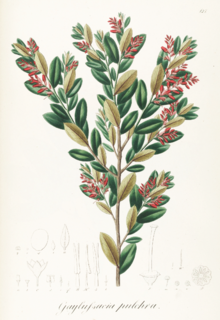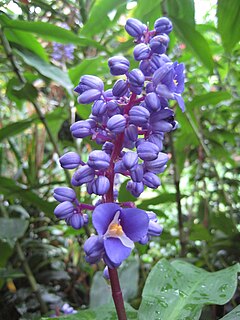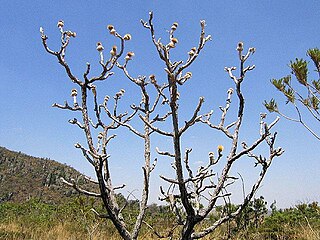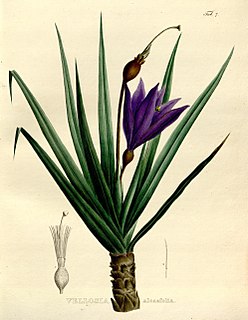Related Research Articles

Psidium is a genus of trees and shrubs in the family Myrtaceae. It is native to warmer parts of the Western Hemisphere.

Manihot is a genus in the diverse milkspurge family, Euphorbiaceae. It was described as a genus in 1754.

Microstachys is a genus of plants in the Euphorbiaceae first described as a genus in 1824. It is native to tropical Africa, southern Asia, Australia, Papuasia, Mesoamerica, the West Indies, and South America.

Gaylussacia is a genus of about fifty species of flowering plants in the family Ericaceae, native to the Americas, where they occur in eastern North America and in South America in the Andes and the mountains of southeastern Brazil. Common English names include huckleberry and "dangleberry".

Formoso is a municipality in northern Minas Gerais state, Brazil. It is located northeast of Brasília, in a pocket where the boundaries of the states of Minas Gerais, Goiás, and Bahia come together.

Dichorisandra is a genus of perennial monocotyledonous flowering plants in the dayflower family (Commelinaceae). It is found in the Neotropics. The genus is characterised by its slightly zygomorphic flowers with large anthers usually releasing pollen by means of pores at the apex, as well as by its seeds that are embedded in a red or sometimes white aril, and tubers that often form at the tips of the roots. Both morphology and an analysis of DNA sequences indicate it is very closely related to the genus Siderasis.

Vriesea is a genus of flowering plants in the botanical family Bromeliaceae, subfamily Tillandsioideae. The genus name is for Willem Hendrik de Vriese, Dutch botanist, physician (1806–1862). Its species are widespread over Mexico, Central America, South America and the West Indies.

Billbergia is a genus of flowering plants in the family Bromeliaceae, subfamily Bromelioideae. The genus, named for the Swedish botanist, zoologist, and anatomist Gustaf Johan Billberg, is divided into two subgenera: Billbergia and Helicodea. They are native to forest and scrub, up to an altitude of 1,700 m (5,577 ft), in southern Mexico, the West Indies, Central America and South America, with many species endemic to Brazil.

Dyckia is a genus of plants in the family Bromeliaceae, subfamily Pitcairnioideae.

Oxypetalum is a genus of flowering plants in the family Apocynaceae, first described with this name in 1810. The genus is native to South America.

Pseudobrickellia is a genus of Brazilian plants in the boneset tribe within the sunflower family.
Symphyopappus is a genus of South American plants in the boneset tribe within the sunflower family.

Dimerostemma is a genus of flowering plants in the daisy family. It now includes all the species in the former genus Angelphytum as the two were merged in 2007.

Wunderlichia is a genus of Brazilian trees in the gerbera tribe within the daisy family.

Actinocephalus is a genus of plants in the Eriocaulaceae, first described in 2004. The entire genus is endemic to Brazil. It was formerly regarded as part of the related genus Paepalanthus, but recent studies have suggested that the two groups are better separated.
Minaria is a genus of flowering plants in the family Apocynaceae, first described as a genus in 2006. They are native to Brazil and Bolivia in South America.

Ditassa is a genus of plant in the family Apocynaceae, first described as a genus in 1810. It is native to South America.

Barbacenia is a plant genus in the family Velloziaceae, described as a genus in 1788. The entire genus is endemic to Brazil with the exception of B. celiae, which crosses the border into Venezuela.

Vellozia is a plant genus in the family Velloziaceae, established in 1788.
References
- 1 2 3 Flann, C (ed) 2009+ Global Compositae Checklist
- ↑ Anderberg, Arne A. 1991. Opera Botanica 104: 141, f. 61B
- ↑ Tropicos, Stenophalium Anderb.
- ↑ The Plant List search for Stenophalium